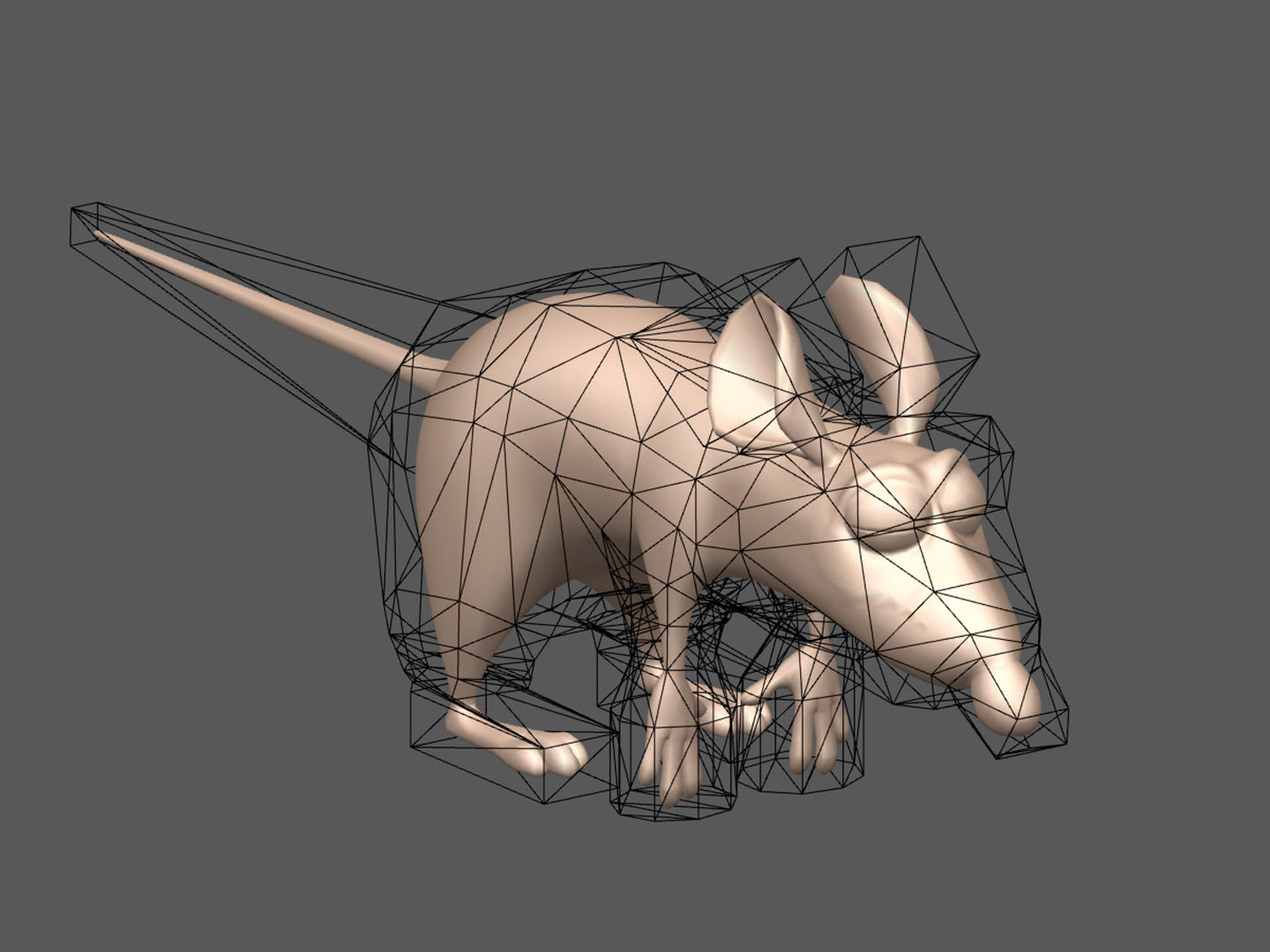“Harmonic coordinates for character articulation” by Joshi, Meyer, DeRose, Green and Sanocki
Conference:
Type(s):
Title:
- Harmonic coordinates for character articulation
Presenter(s)/Author(s):
Abstract:
In this paper we consider the problem of creating and controlling volume deformations used to articulate characters for use in high-end applications such as computer generated feature films. We introduce a method we call harmonic coordinates that significantly improves upon existing volume deformation techniques. Our deformations are controlled using a topologically flexible structure, called a cage, that consists of a closed three dimensional mesh. The cage can optionally be augmented with additional interior vertices, edges, and faces to more precisely control the interior behavior of the deformation. We show that harmonic coordinates are generalized barycentric coordinates that can be extended to any dimension. Moreover, they are the first system of generalized barycentric coordinates that are non-negative even in strongly concave situations, and their magnitude falls off with distance as measured within the cage.
References:
1. Bass, R. 1995. Probabilistic Techniques in Analysis. Springer-Verlag.Google Scholar
2. Capell, S., Green, S., Curless, B., Duchamp, T., and Popovic, Z. 2002. A multiresolution framework for dynamic deformations. In ACM SIGGRAPH Symposium on Computer Animation, ACM SIGGRAPH, 41–48. Google ScholarDigital Library
3. Carr, J. C., Beatson, R. K., Cherrie, J. B., Mitchell, T. J., Fright, W. R., McCallum, B. C., and Evans, T. R. 2001. Reconstruction and representation of 3D objects with radial basis functions. In SIGGRAPH 2001, Computer Graphics Proceedings, ACM Press / ACM SIGGRAPH, E. Fiume, Ed., 67–76. Google ScholarDigital Library
4. Choe, B., Lee, H., and Ko, H.-S. 2001. Performance-driven muscle-based facial animation. The Journal of Visualization and Computer Animation 12, 2, 67–79.Google ScholarCross Ref
5. DeRose, T., and Meyer, M. 2006. Harmonic coordinates. Pixar Technical Memo 06–02, Pixar Animation Studios, January, http://graphics.pixar.com/HarmonicCoordinates/.Google Scholar
6. Duchon, J. 1977. Splines minimizing rotation invariant seminorms in sobolev spaces. In Lecture Notes in Mathematics, Springer-Verlag, vol. 571.Google Scholar
7. Floater, M. S., Kos, G., and Reimers, M. 2005. Mean value coordinates in 3d. Computer Aided Geometric Design 22, 623–631. Google ScholarDigital Library
8. Floater, M. S., Hormann, K., and Kos, G. 2006. A general construction of barycentric coordinates over convex polygons. Advances in Comp. Math. 24, 311–331.Google ScholarCross Ref
9. Floater, M. 2003. Mean value coordinates. Computer Aided Geometric Design 20, 1, 19–27. Google ScholarDigital Library
10. Igarashi, T., Moscovich, T., and Hughes, J. F. 2005. Asrigid-as-possible shape manipulation. In SIGGRAPH ’05: ACM SIGGRAPH 2005 Papers, ACM Press, New York, NY, USA, 1134–1141. Google ScholarDigital Library
11. Joshi, P., Tien, W. C., Desbrun, M., and Pighin, F. 2006. Learning controls for blend shape based realistic facial animation. In SIGGRAPH ’06: ACM SIGGRAPH 2006 Courses, ACM Press, New York, NY, USA, 17. Google ScholarDigital Library
12. Joshi, P., Meyer, M., DeRose, T., Green, B., and Sanocki, T. 2007. Harmonic coordinates for character articulation. Pixar Technical Memo 06–02b, Pixar Animation Studios. http://graphics.pixar.com/HarmonicCoordinatesB/.Google Scholar
13. Ju, T., Schaefer, S., and Warren, J. 2005. Mean value coordinates for closed triangular meshes. ACM Trans. Graph. 24, 3, 561–566. Google ScholarDigital Library
14. Lewis, J. P., Cordner, M., and Fong, N. 2000. Pose space deformation: a unified approach to shape interpolation and skeleton-driven deformation. In Proceedings of the 27th annual conference on Computer graphics and interactive techniques, 165–172. Google ScholarDigital Library
15. Loop, C. T., and DeRose, T. D. 1989. A multisided generalization of bézier surfaces. ACM Trans. Graph. 8, 3, 204–234. Google ScholarDigital Library
16. MacCracken, R., and Joy, K. I. 1996. Free-form deformations with lattices of arbitrary topology. In Proceedings of SIGGRAPH ’96, Annual Conference Series, 181–199. Google ScholarDigital Library
17. Meyer, M., Lee, H., Barr, A., and Desbrun, M. 2002. Generalized barycentric coordinates for irregular polygons. Journal of Graphics Tools 7, 1, 13–22. Google ScholarDigital Library
18. Pinkhall, U., and Polthier, K. 1993. Computing discrete minimal surfaces and their conjugates. Experimental Mathematics 2, 15–36.Google ScholarCross Ref
19. Port, S. C., and Stone, C. J. 1978. Brownian Motion and Classical Potential Theory. Academic Press.Google Scholar
20. R. Sibson. 1981. A brief description of natural neighbor interpolation. In Interpreting Multivariate Data, V. Barnett, Ed. John Wiley, 21–36.Google Scholar
21. Sederberg, T. W., and Parry, S. R. 1986. Free-form deformation of solid geometric models. In SIGGRAPH ’86: Proceedings of the 13th annual conference on Computer graphics and interactive techniques, ACM Press, New York, NY, USA, 151–160. Google ScholarDigital Library
22. Shi, L., Yu, Y., Bell, N., and Feng, W.-W. 2006. A fast multi-grid algorithm for mesh deformation. In SIGGRAPH ’06: ACM SIGGRAPH 2006 Papers, ACM Press, New York, NY, USA, 1108–1117. Google ScholarDigital Library
23. Sorkine, O. 2006. State of the art report: Differential representations for mesh processing. Computer Graphics Forum 25, 4.Google ScholarCross Ref
24. Sumner, R. W., Zwicker, M., Gotsman, C., and Popovic, J. 2005. Mesh-based inverse kinematics. ACM Trans. Graph. 24, 3, 488–495. Google ScholarDigital Library
25. Wachpress, E. 1975. A Rational Finite Element Basis. Academic Press.Google Scholar
26. Wahba, G. 1990. Spline models for observational data. In CBMS-NSF Regional Conference Series in Applied Mathematics, SIAM, Philadelphia, PA, USA, vol. 59.Google Scholar
27. Warren, J. 1996. Barycentric coordinates for convex polytopes. Advances in Computational Mathematics 6, 97–108.Google ScholarCross Ref
28. Zayer, R., Rössl, C., Karni, Z., and Seidel, H.-P. 2005. Harmonic guidance for surface deformation. In The European Association for Computer Graphics 26th Annual Conference: EUROGRAPHICS 2005, Blackwell, Dublin, Ireland, M. Alexa and J. Marks, Eds., vol. 24 of Computer Graphics Forum, Eurographics, 601–609.Google Scholar





